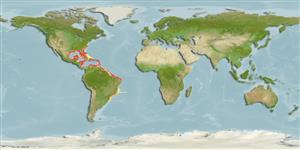Common names from other countries
Environment: milieu / climate zone / depth range / distribution range
Sinh thái học
; Mức độ sâu 0 - 525 m (Ref. 83435). Tropical
Western Atlantic: North America and Caribbean. Introduced in Easter Central Pacific.
Length at first maturity / Bộ gần gũi / Khối lượng (Trọng lượng) / Age
Maturity: Lm ? range ? - ? cm Max length : 10.0 cm WD con đực/không giới tính; (Ref. )
Brightly colored, heavy shelled bivalve with long, ribbed, leafy projections in radiating rows. Commonly yellow or orange, although some are pinkish. Inside is white. Highly variable in form, lower valve conforms to the shape of the substrate, upper valve usually becomes worn and looses color and sculpture.
Lives fixed to the substrate, with lower valve cemented in place (Ref. 3248). In Belize, it was found in a submarine cave near Columbus Cay (Ref. 87209).
Life cycle and mating behavior
Chín muồi sinh dục | Sự tái sinh sản | Đẻ trứng | Các trứng | Sự sinh sản | Ấu trùng
Members of the class Bivalvia are mostly gonochoric, some are protandric hermaphrodites. Life cycle: Embryos develop into free-swimming trocophore larvae, succeeded by the bivalve veliger, resembling a miniature clam.
DeFelice, R.C., L.G. Eldredge and J.T. Carlton. 2001. (Ref. 3248)
IUCN Red List Status (Ref. 130435)
CITES status (Ref. 108899)
Not Evaluated
Not Evaluated
Human uses
| FishSource |
Các công cụ
Thêm thông tin
Age/SizeSự sinh trưởngLength-weightLength-lengthHình thái họcẤu trùngSự phong phú
Các nguồn internet
Estimates based on models
Preferred temperature
(Ref.
115969): 14.6 - 26.3, mean 20.7 (based on 160 cells).
Vulnerability
Low vulnerability (10 of 100).
Price category
Unknown.
